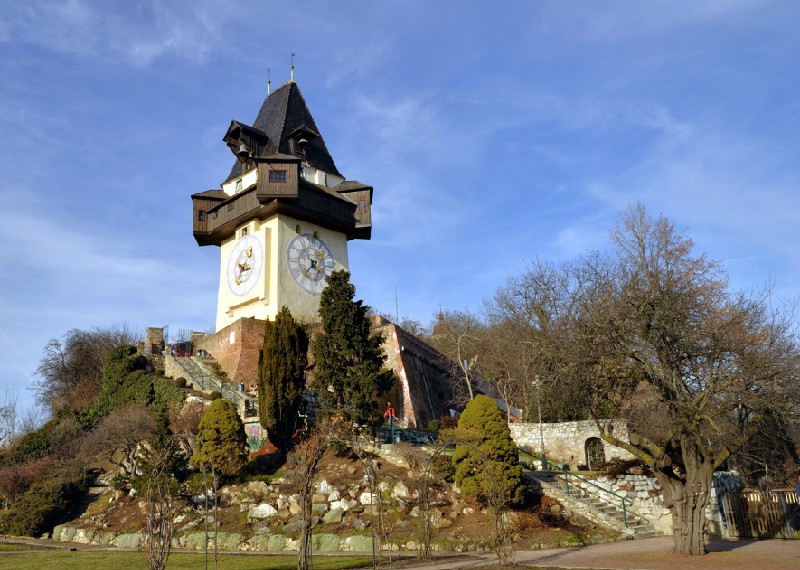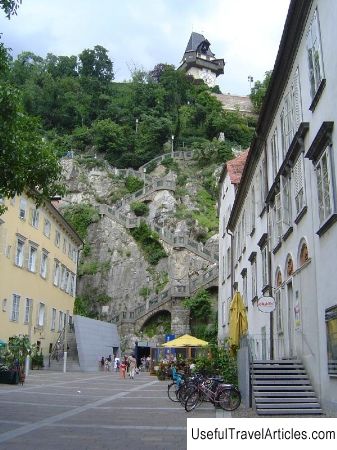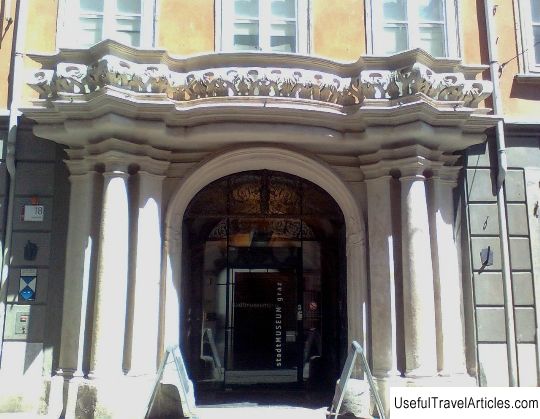Graz. Recreation and entertainment
Rating: 8,9/10 (1642 votes)  HistoryThe history of the city begins with a small defensive fortress at the top of the Schlossberg Upland. Graz also got its name from her, the fortress was called the Slavic word `` gradets '', which meant `` small fortress. '' From the very beginning of the formation of Graz, many rulers changed in it, including from Germany, Bohemia, Hungary, representatives of the Habsburg and Babenberg dynasties. The city developed most actively in the Middle Ages. Some structures from this late Gothic period have survived to this day.  Schlossberg Graz received the status of a city in 1240, during the Middle Ages it was the capital of Styria, and since the 16th century - and ndash; the capital of Upper Austria. In the XVIII-XIX centuries, Graz grew rich and developed, becoming a major cultural and educational center of the country. During the Napoleonic campaigns, the city was captured by the French three times, its fortress was destroyed. During the Second World War, bombing raids inflicted heavy damage on city buildings. However, in the post-war years, most of the buildings were restored. During the Middle Ages and the Renaissance, Graz was the seat of the Habsburgs and flourished. The legacy of this era – beautiful and one of the best preserved historic Old Towns. The Old Town, the center of Graz, has a unique lively atmosphere: there are many pedestrian zones, souvenir shops, bars, cafes, shops, street musicians entertain passers-by at every corner. Old and new are closely adjacent in the streets of the city. In 1999, the Old Town of Graz was included in the UNESCO list of cultural heritage sites. In 2003, Graz was awarded the status of the European Capital of Culture. In addition, the city has long been a student city (their total number – more than 36 thousand people)  Clock Tower TourismGraz – one of the most distinctive Austrian cities. Architectural and historical monuments of the city are of the greatest interest. Here you can visit the episcopal palace, the ruins of the Schlossberg castle, erected in the XI century, destroyed by Napoleon, the Urturm clock tower, which is the symbol of the city and standing on a mountain 475 meters above sea level, the Glockenturm bell tower, the Cathedral of the Teutonic knights of the XIII century, the Town Hall, the Domkirche church of the XII centuries and many other witnesses of antiquity. In addition, the so-called Land of Lakes, which includes lakes Grundlsee, Altaussersee, Toplitzsee, Stubenbergsee, Peggau, surrounded by beautiful landscapes with mountains, cliffs, rocky shores and caves. In particular, Lake Peggau has picturesque stalactite caves that can be visited. These places have always attracted tourists and artists with their natural beauty and clean air. You can explore the surroundings and enjoy the scenery from a bird's eye view from the hot air balloon, which is regularly held for tourists. Graz hosts an interesting annual festival of avant-garde art called Styrian Autumn, during which the city various theatrical performances, exhibitions and installations are arranged.  Town Hall AttractionsSchlossberg – the ruins of an ancient defensive fortress on a high green mountain are today arranged as a restored open stage. You can climb a mountain with a height of 475 meters above sea level in different ways, the most convenient – by cable car. Clock Tower – tower on the Schlossberg mountain, the symbol of the city. The clockwork of the tower has been operating since 1712 without interruption. An old bell, one of the oldest in Austria (1382), is installed in the tower. The wooden passage to the tower is entwined with ivy, with numerous love stories associated with it. Schlossberg Cable Car – funicular that has been taking people up the mountain since 1894. It is more interesting to descend down the steep steps cut into the rock. Arsenal – the armory next to the Landhouse, built in 1551. Today the arsenal is the world's largest collection of historical weapons – more than 30 000 items. Town Hall – the town hall, built in the southern part of the main square of the city. This is the third town hall built on this site. The area is very lively with many stalls and stalls. In the center of the square – fountain of Archduke Johann. Luegg – a house with rich baroque stucco, built in the 13th century.  Landhouse Landhouse – yard and house, the crown of the Italian Renaissance. The house and the courtyard surrounding it with arcades – a masterpiece of 16th century architecture. Today concerts and performances are held here. Shporgasse – a very romantic alley, narrow, winding and steep, skirting the Schlossberg mountain. Burg Fortress – an imposing 15th century sandstone building. It is famous for its imposing late Gothic double spiral staircase. Today it houses the government of Styria. Opera – the opera house was built at the end of the 19th century according to the project of the most famous architects of Europe Helmer and Fellner. The building reflects the meeting of traditional and modern style. Cathedral and Mausoleum – the cathedral in the Gothic style was erected in 1438, and in 1614 the Mausoleum was built nearby. Combined with the Burg Fortress, the old Jesuit University and the theater, these buildings form the 'city crown of Graz'. Peasant markets – Markets at Kaiser-Josef-Platz and Landplatz. Styrian gardens and orchards are located in the suburbs of Graz, the country's climatic conditions allow agriculture to flourish. In such markets, you can buy traditional national products, for example, pumpkin seed oil.  Eggenberg Castle Eggenberg Castle – the largest and most magnificent castle in Styria. Built in 1625, the outside of the castle is decorated in the Mannerist style, while the interior is an organic fusion of Baroque and Rococo. Today musical performances are held in the castle. Schwarzenegger Museum – Museum, opened in the native village of the actor Arnold Schwarzenegger Tal-Graz, near Graz. The museum's collection includes images, personal belongings of the former bodybuilder, for example, his crib. Also in the museum is a motorcycle from the movie Terminator, which the actor rode. Cathedral of Saint Egidius – the cathedral, built in 1438-1462, with baroque interiors. The cathedral is decorated with beautiful stained glass windows. House of Culture – the building was built in 2003 by the architects K. Fournier and P. Cook. It has become a new symbol of the city. The building organically combines tradition and avant-garde. It hosts a variety of exhibitions. Murinsel – artificial island on the river Mur. Designed by the architect V. Acconci, the island is a floating shell. Inside it is a cafe and an amphitheater.  We also recommend reading Frantiskovy Lazne. Recreation and entertainment Topic: Graz. Recreation and entertainment. |




